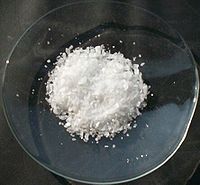
Photo from wikipedia
Growing environmental awareness imposes on polymer scientists the development of novel materials that show a longer lifetime and that can be easily recycled. These challenges were largely met by vitrimers,… Click to show full abstract
Growing environmental awareness imposes on polymer scientists the development of novel materials that show a longer lifetime and that can be easily recycled. These challenges were largely met by vitrimers, a new class of polymers that merges properties of thermoplastics and thermosets. This is achieved by the incorporation of dynamic covalent bonds into the polymer structure, which provides high stability at the service temperature, but enables the processing at elevated temperatures. Numerous types of dynamic covalent bonds have been utilized for the synthesis of vitrimers. Amongst them, boronic acid-based linkages, namely boronic acid esters and boroxines, are distinguished by their quick exchange kinetics and the possibility of easy application in various polymer systems, from commercial thermoplastics to low molecular weight thermosetting resins. This review covers the development of dynamic cross-links. This review is aimed at providing the state of the art in the utilization of boronic species for the synthesis of covalent adaptable networks. We mainly focus on the synthetic aspects of boronic linkages-based vitrimers construction. Finally, the challenges and future perspectives are provided.
Journal Title: Polymers
Year Published: 2022
Link to full text (if available)
Share on Social Media: Sign Up to like & get
recommendations!